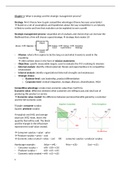Summary
Complete summary of Strategy for Pre-master, lectures + book
- Course
- Institution
- Book
Complete summary of Strategy for Pre-master All lectures covered + mandatory book chapters Book used: Strategic management and competitive advantage; Barney College year:
[Show more]



